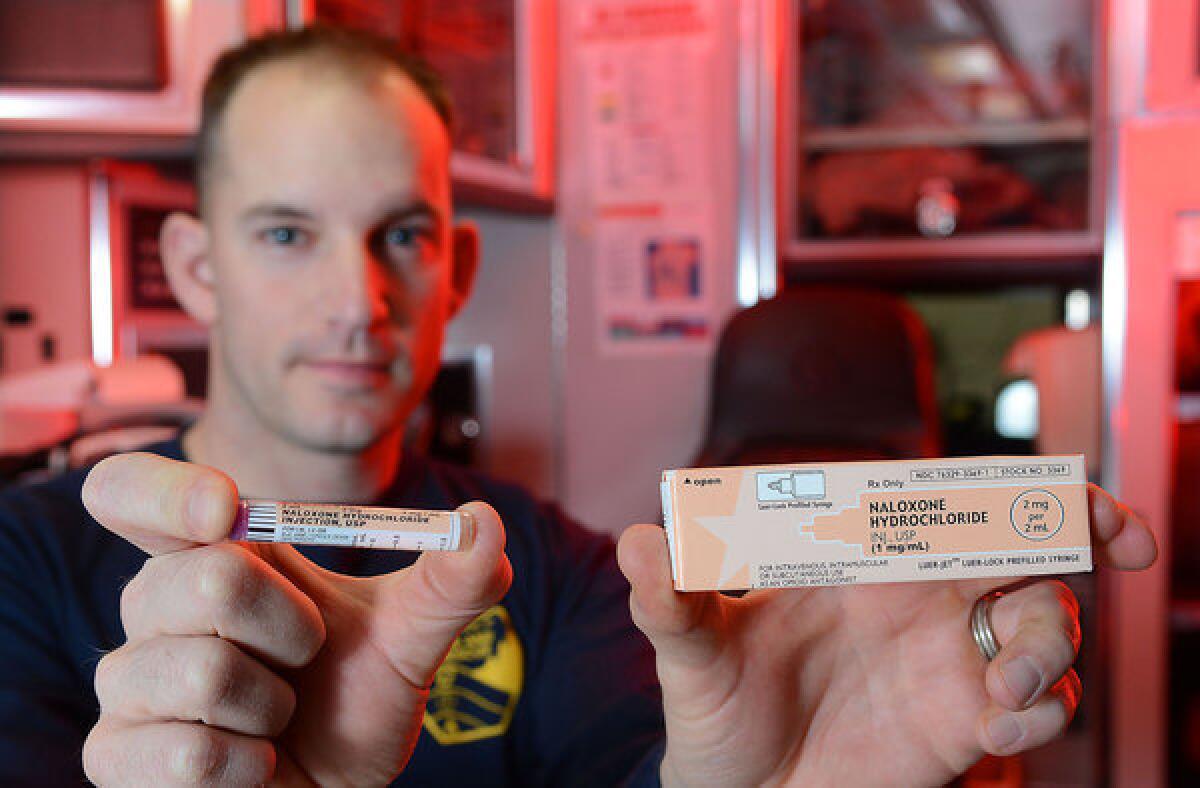Opinion: Philip Seymour Hoffman: Naloxone could spare others from his fate

- Share via
Now that we’ve had time to digest the news of Philip Seymour Hoffman’s death from an apparent heroin overdose on Feb. 2, and to debate the nature of addiction, the conversation has started to shift to the country’s surge in heroin use and how to prevent accidental deaths with naloxone.
Naloxone, if you haven’t yet heard, is a highly effective, nonaddictive drug used to reverse overdoses. Lynne Lyman, California state director for the Drug Policy Alliance, actually wrote an Op-Ed about it in last year’s Opinion pages, making a persuasive case for expanding its availability. “We have a powerful weapon against drug overdoses,” she argued.
She explained:
“Naloxone (trade name: Narcan) is a low-cost, generic drug approved by the FDA in 1971. Talk to any cop, firefighter or emergency room doctor, and they know all about its ability to reverse a potentially fatal opiate overdose. The drug is easy to administer, either as an intramuscular injection or through a nasal spray, and it has no negative side effects. But many of the people most likely to discover someone in need of naloxone have never heard of it.
“When I found this out, I wanted to run to the nearest drugstore, buy it up and start handing it out. It seemed to me almost as much a no-brainer as condom distribution for preventing AIDS. Using naloxone is, of course, a little more complicated than using condoms for AIDS prevention because it requires a prescription to obtain it and a third party to administer it. But the basic idea is the same: Those who engage in potentially risky behavior should be encouraged to take precautions. […]
“There’s no good reason naloxone is so underutilized: It’s simply a failure of education and planning. It’s not a narcotic and has no recreational use. You can’t get addicted to it. Its only purpose is to reverse an opiate overdose, which it does by ejecting opiods from receptors in the brain, thus reversing the respiratory depression that can lead to death.
“So what are the barriers to its routine use?”
Lyman details those barriers here, along with suggestions for how to remove them.
White House drug czar R. Gil Kerlikowske also favors expanding the availability of naloxone. Kerlikowske told reporters Tuesday that “co-prescribing to both the person who is going through the disease of addiction and to their relatives and significant others can be very helpful.” He also noted: “We are not going to arrest our way out of this drug problem.”
None of this is to say naloxone is a pleasant solution. As Heather Edney shared with my colleague Matt Pearce:
“Heather Edney, 43, of Los Angeles can’t remember how many times she has been revived with naloxone, perhaps five. But the last time she was saved by the drug, 10 years ago, was also the last time she ever used heroin.
“Naloxone ‘absolutely’ saved her life, she said. The people she was with were not going to call 911 “because they could have legal ramifications,” she said.
“ ‘I got a second chance at life,’ said Edney, now a behavioral healthcare consultant who helps organize drug treatment programs. ‘I’ve been living an amazing life for 10 years. I’ve been helping other people get treatment — none of that happens without naloxone.’ […]
“Edney dismissed the possibility that providing naloxone to heroin addicts would only enable them to overdose again. ‘When you’re using, you’re using,’ she said. ‘For me, I used to use it [heroin] because I wasn’t even thinking about it, let alone naloxone.’
“Getting a dose of naloxone isn’t pleasant, she said. It’s like waking up, except with sudden opium withdrawal symptoms, depending on how quickly a user is brought out of an overdose.”
But it can be a life-saving solution.
“It’s rare that a leading cause of death is so preventable, which makes the underutilization of naloxone all the more tragic,” Lyman wrote. “We need to ensure that it is available wherever it might save lives.”
Read Lyman’s Op-Ed in full: “Drug overdose prevention could be right at our fingertips.”
ALSO:
Ideas for stopping wrong-way drunk drivers
Woody Allen vs. Dylan Farrow, art vs. scandal
Will Philip Seymour Hoffman’s death help us to rediscover privacy?
Follow Alexandra Le Tellier on Twitter @alexletellier and Google+
More to Read
A cure for the common opinion
Get thought-provoking perspectives with our weekly newsletter.
You may occasionally receive promotional content from the Los Angeles Times.









